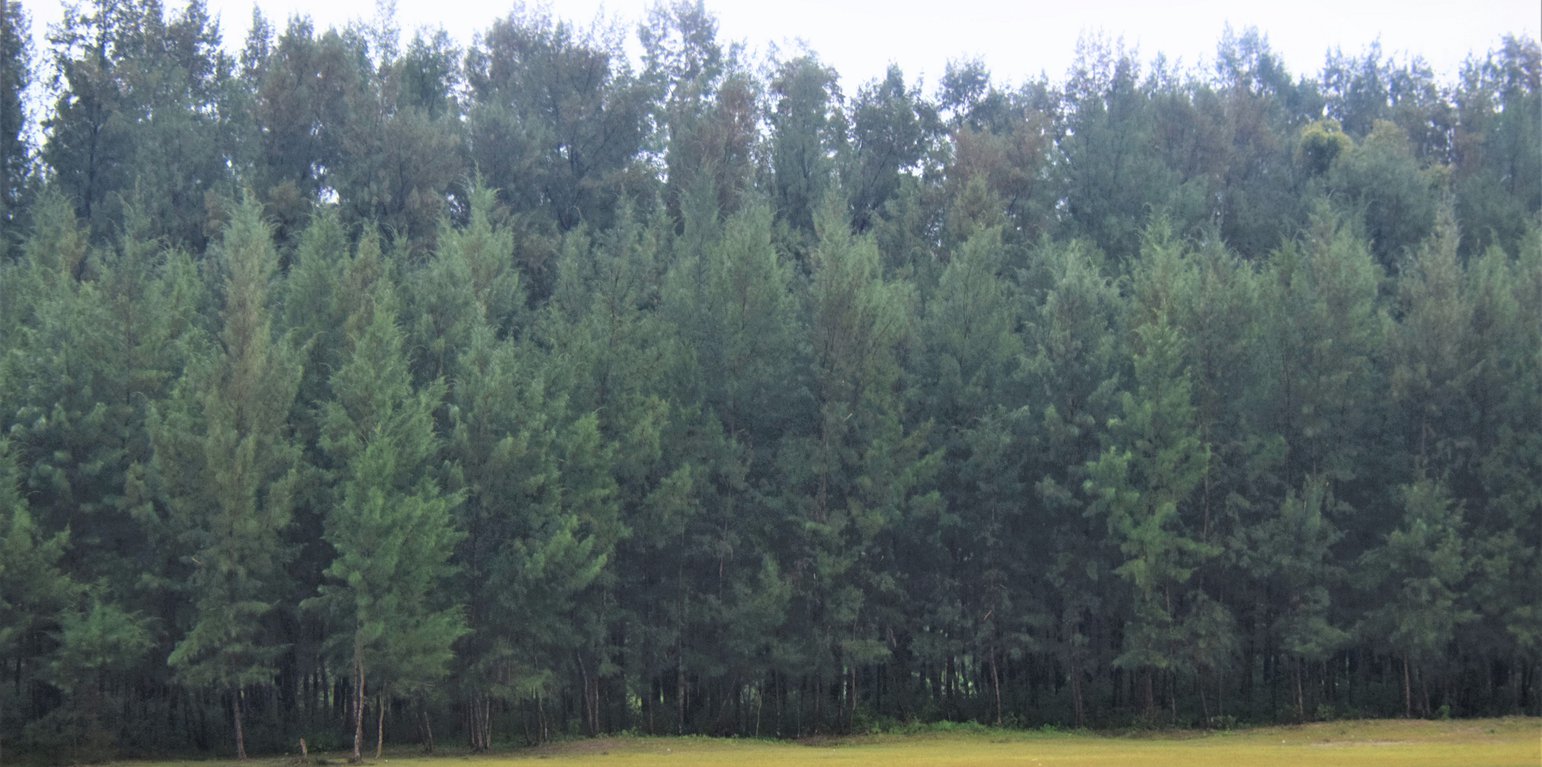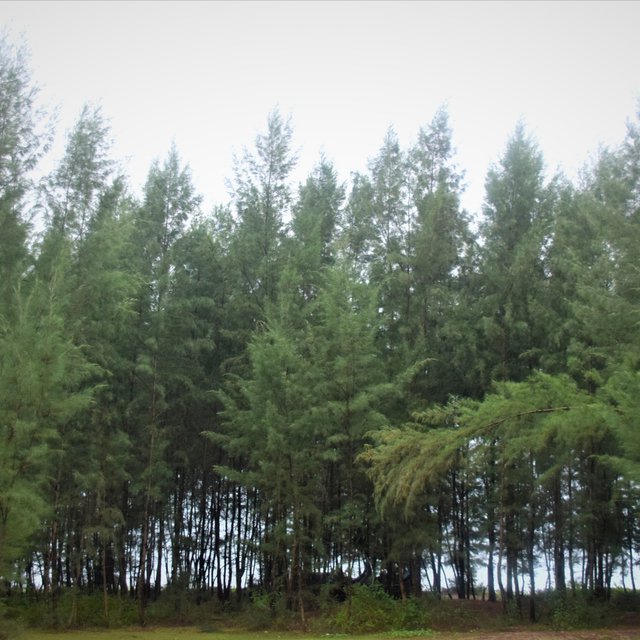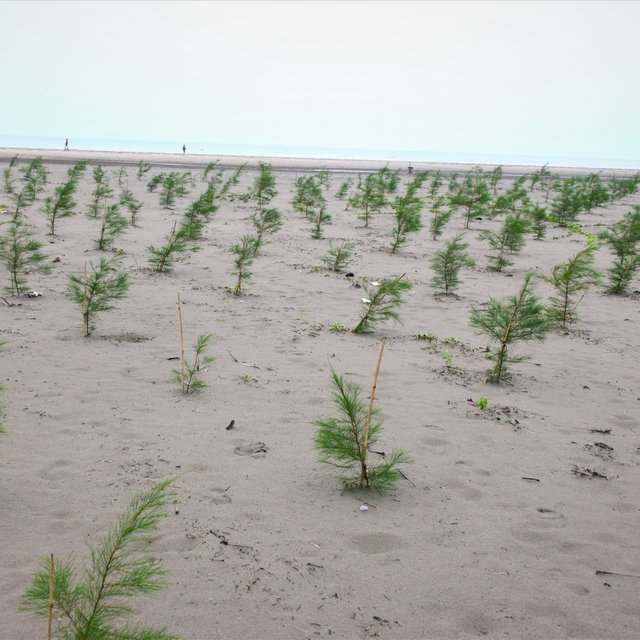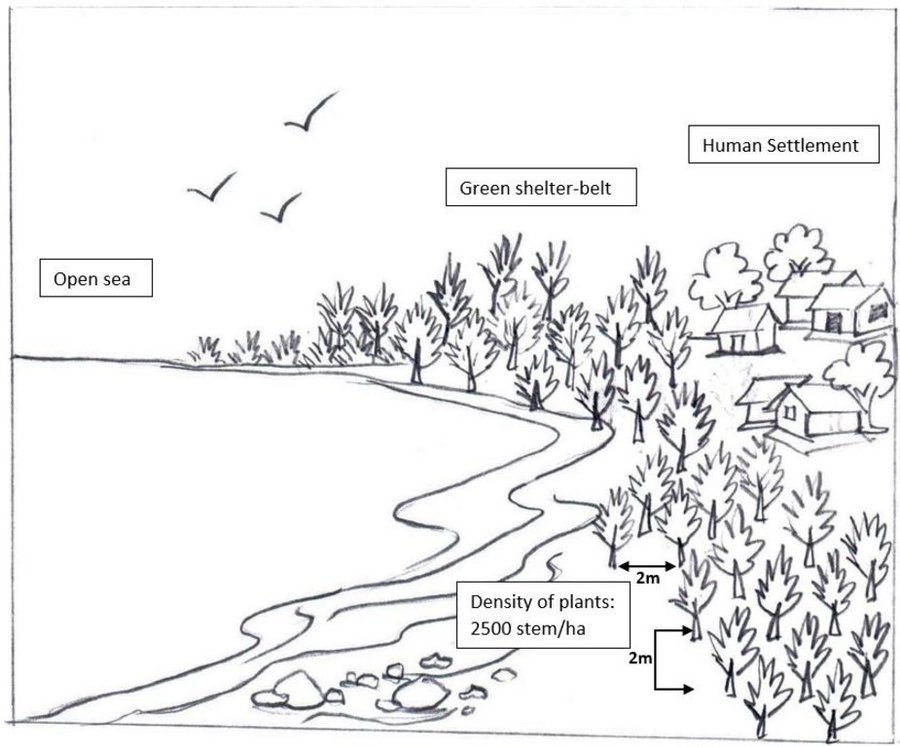



The coastal zone of Bangladesh is extremely vulnerable to the impact of climate change. The coastal populations are mostly poor and some of them are landless with livelihoods connected to agriculture, fishing, shrimp farming, salt farming etc. Past devastating cyclones have killed thousands of people and destroyed homes and infrastructure. Creation of green shelter-belts, including mangrove and non-mangrove plantations, reduces the vulnerabilities and hazards related to extreme weather events like cyclones and storm surges. Afforestation along coastal areas is usually cheaper and ecologically more beneficial than other measures and serves to conserve biodiversity and stabilize newly accreted land. As a general guideline, a shelter-belt protects an area over a distance up to its own height on the windward side and up to 10 times its height on the leeward side, depending on the strength of the wind.
The current sustainable land management practice takes particular account of the Jhau plantation along the coastline of Himchari National Park of Cox's Bazar. Jhau (Casuarina equisetifolia) is one of the most promising non-mangrove species for creating shelter-belts and the Bangladesh Forest Department has been planting them in raised coastal lands and embankments since the 1990s. Casuarina equisetifolia is an evergreen tree with a finely branched, feathery crown and usually growing around 35 meters tall. It is fast growing, salt tolerant, grows in sand and can also tolerate occasional inundation by sea water at extremely high tides. Many areas where the species naturally occurs are susceptible to tropical cyclones, and its general tolerance to strong winds has encouraged its use in protective planting. The most common uses of C. equisetifolia are for coastal sand dune stabilization, shelter-belts, land reclamation and erosion control. The wood is hard and used for house posts, rafters, electric poles, tool handles, etc. It has been called ‘the best firewood in the world’ and also produces high-quality charcoal.
Coastal plantation with Jhau is a soft adaptation measure that has significantly contributed to reduce the loss of lives and properties against tropical cyclones and storm surges in the coastal areas. This species can be planted in coastline, roadside, embankment and marginal lands for creating dense vegetation, which can function as windbreak and combat tidal surges. The spacing used in this shelter-belt plantation along the coastline of Himchari National Park is 2m x 2m and 2500 trees are planted per hectare area. The examined shelter-belt plantations are approximately 1.5km long and 150m wide. The major activities required to establish the plantation were: nursery development (seed collection, site clearing, leveling and fencing, drainage arrangement, bed preparation, making overhead shed, poly-bag preparation, potting seeds, manuring, irrigation, weed control), site preparation (prepare plantation site map with GPS, weeding, marking pit location with sticks, carrying of seedlings to the site) and tree planting (digging of planting holes, tying up of plants with stick for support, application of fertilizers and compost). Weeding and vacancy filling were the maintenance activities which required up to three years after plantation establishment. All those activities carried out by the forest department with the financial help from world bank project fund. The local communities were involved as paid labour for nursery development, plantation and maintenance activities. Local people can only collect fuel wood from the plantation as its soul purpose is to act as shelter-belt from cyclones and tidal surge.
As the plantation site is on the coastline and beside the Himchari National Park, it turns to a tourist spot now for its scenic beauty. Local people involved with various sorts of tourist oriented small-scale business here e.g. parasailing, boating, restaurant, cottage industries, shops, etc. Though the initial establishment of Jhau stand need intensive care, it is functioning as a good wind breaker and combating with tidal surge along with creating alternate livelihood opportunities for local people.

Байршил: Hiimchari, Cox's Bazar, Chittagong, Бангладеш
Дүн шинжилгээнд хамрагдсан технологи нэвтрүүлсэн газрын тоо: 2-10 байршилд
Технологийн тархалт: газар дээр жигд тархсан (approx. 0.1-1 км2)
Тусгай хамгаалалттай газар нутагт?: Үгүй
Хэрэгжилтийн огноо: 10-50 жилийн өмнө
Нутагшууллын төрөл






| Зардлын нэр, төрөл | Хэмжих нэгж | Тоо хэмжээ | Нэгжийн үнэ (BDT) | Зардал бүрийн нийт өртөг (BDT) | Нийт дүнгээс газар ашиглагчийн төлсөн % |
| Хөдөлмөр эрхлэлт | |||||
| Nursery preparation | person-days | 17.0 | 500.0 | 8500.0 | |
| Site preparation | person-days | 7.0 | 500.0 | 3500.0 | |
| Planting activities | person-days | 22.0 | 500.0 | 11000.0 | |
| Тоног төхөөрөмж | |||||
| Bucket | pieces | 10.0 | 150.0 | 1500.0 | |
| Spade | pieces | 8.0 | 300.0 | 2400.0 | |
| Scissor | pieces | 2.0 | 150.0 | 300.0 | |
| Knife | pieces | 2.0 | 200.0 | 400.0 | |
| Бордоо ба биоцид | |||||
| Cow dung | cubic meter | 1.0 | 1200.0 | 1200.0 | |
| Urea | kg | 6.0 | 35.0 | 210.0 | |
| MoP | kg | 6.0 | 30.0 | 180.0 | |
| TSP | kg | 6.0 | 40.0 | 240.0 | |
| Compost | kg | 1250.0 | 4.0 | 5000.0 | |
| Барилгын материал | |||||
| Poly bag | pieces | 3000.0 | 0.8 | 2400.0 | |
| Bamboo stick | pieces | 2600.0 | 2.0 | 5200.0 | |
| Signboard | Lump sum | 1.0 | 1000.0 | 1000.0 | |
| Технологи бий болгох нийт үнэ өртөг | 43'030.0 | ||||
| Технологи бий болгох нийт үнэ өртөг, ам.доллар | 518.43 | ||||
| Зардлын нэр, төрөл | Хэмжих нэгж | Тоо хэмжээ | Нэгжийн үнэ (BDT) | Зардал бүрийн нийт өртөг (BDT) | Нийт дүнгээс газар ашиглагчийн төлсөн % |
| Хөдөлмөр эрхлэлт | |||||
| 1st year Weeding (6 labor/weeding/Ha.) 3 times | person-days | 18.0 | 500.0 | 9000.0 | |
| 2nd year Weeding (5 labor/weeding/Ha.) 3 times | person-days | 15.0 | 500.0 | 7500.0 | |
| 3rd year Weeding (5 labor/weeding/Ha.) 2 times ng and cleaning (5 labor/weeding/Ha.) 1 time | person-days | 10.0 | 500.0 | 5000.0 | |
| Vacancy filling | person-days | 5.0 | 500.0 | 2500.0 | |
| Тоног төхөөрөмж | |||||
| Bamboo stick | pieces | 1000.0 | 2.0 | 2000.0 | |
| Технологийн арчилгаа/урсгал үйл ажиллагаанд шаардагдах нийт үнэ өртөг | 26'000.0 | ||||
| Технологи арчилах ба урсгал ажлын нийт үнэ өртөг, ам.доллар | 313.25 | ||||
leaves and fruits are used for ornamental purposes
Jhau tree performs better than other trees for stabilization of coastal sand dune
the plantation site now become a picnic spot for its scenic beauty (tourism has been attracted because of the coastal plantation)
The area attract more tourists now and local people involved in various type of small scale business here
The workload reduced due to diversified income source of local community
New year celebration program now organized here every year
This area now become a tourist hotspot
Learn about the stabilization of sand dunes
The green belt support home for native birds
protection of agricultural land on back side of shelter-belt